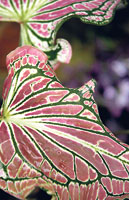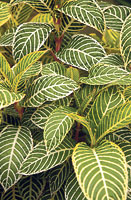Our home gardens are an important part of the home. If you feel your garden is lacking in variety or colour, don’t despair - there are many ways to enliven it.
Foliage plants are one way to bring variety to your garden. And, there is a vast range of such plants to select from. One group of foliage plants have artistic leaves, like the caladium (tricolour). The shape, colour and leaf arrangement is inimitable in each plant.
It is easy to grow foliage plants either in the ground or as pot plants. Pot plants are the choice for small gardens. These can be looked after easily and re-arranged at will in the garden space. Pot plants require a lesser amount of nutrients and water. But of course certain foliage plants do well in the ground. So a medium sized garden or a larger garden can have an admixture of both types.
Aspects to consider for pot plants
potting medium
The planting medium for pot plants (potting medium, soil) must be somewhat porous. The medium must not be too tight, nor too loose. Roots cannot grow in a tight medium. The pot gets waterlogged and water does not hold well in a loose medium. Prepare the potting medium to suit the foliage plant. The correct texture or consistency can be arrived at by mixing varying proportions of earth, sand, compost (and or coir dust).
Once the plant is potted, consider the following three factors: Sunlight, watering and soil moisture.
- Some plants need full sunlight (no shade – grow in the open)
- Some need partial sunlight (semi-shade – grow in uncovered shady spots)
- Others need very little sunlight (sheltered – grow under a sun cover)
Sunlight: Pot plants can be easily shifted from place-to-place to get adequate sunlight. If the leaves get scorched there is too much of sun. If the leaves are pale, sometimes too green, there is not enough light. You can provide the plant with correct light intensity by trial and error.
 |
| Caladiums |
Water: Some plants require regular spraying of leaves with water; some need watering once a day or in wider gaps. Rainfall or dry weather also dictate the water requirement of plants. Do not spray leaves when the sun is up.
The soil moisture requirement of different foliage plants varies. Some plants need moist soil throughout and the medium must never dry out.
Some require moderately moist soil; the soil is allowed to dry slightly between watering. Others prefer a reasonably dry medium. Excessive watering can choke the root system and kill a plant due to rotting.
Remember, spraying is to wet the leaves and watering to wet the soil.
Pot binding
After a little time if your plant is not doing as well as it used to do before, it could be because of pot-binding. This is due to roots getting enmeshed and entangled within the pot. The medium gets depleted. Growth retardation becomes evident. The plant is said to be pot-bound. So what can you do to reinvigorate a pot-bound plant? Remove the plant with the clump of soil out of the pot. Force out the entrapped soil from entangled roots by hosing. Trim dead and decayed roots and replant in fresh potting medium. You should have a rejuvenated plant.
Here are some plants you can pick to brighten your garden:
Caladiums
There are many varieties of caladiums to select from. If it is the artistic leaf-forms you are after, Caladium varieties could be your choice. These are easily obtained and easy to grow. Start with a tuber or with a sapling. The sapling can be planted in a pot or directly in the garden. Caladiums require less light. Spray water regularly. Never allow the soil to dry out, but keep moist. These usually grow disease-free in our climate. Potted Caladiums can be taken inside for indoor decor.
Begonias
There are many varieties of begonia. Some produce large panicles of flower. Others are for foliage. The Iron-cross is one such begonia. These are grown in loose potting medium, with less soil – more sand – coir dust – compost. Begonias require light, but not full sunlight. Grow these in shady spots. Spray leaves with water regularly. Keep the potting medium moderately moist, allowing it to dry slightly between watering. Begonias need close attention and have a limited lifespan.
Codiaeums
 |
| ‘Silver Queen’, |
Codiaeums are commonly known as Crotons. In Sinhala these are known as ‘Nagawalli’ referring to beautiful foliage. Grow these for colourful, varying leaf-shape. Codiaeum can be grown in pots and kept dwarfed. They can be planted directly in the garden and trimmed as desired. These need less sunlight, regular spraying and generous watering. Codiaeum is easily propagated with cuttings. Cuttings kept in water, spring out roots in a short time ready for planting.
Euphorbia
There are many to choose from-- some leafy, some flowering and some skinny. All are prickly so take care not to get pricked! They are best grown in pots. The rooting medium can be somewhat tight packed. Euphorbias prefer ‘dry feet’. Keep the soil moderately dry by watering less and infrequently. Spray leaves and stem regularly.
Coleus
Grow coleus for colourful artistic leaves. It is a succulent plant that can be easily propagated with cuttings. Coleus makes the garden look attractive when grown in clumps or as rows. These plants make attractive pot plants too. Coleus prefers a loose medium prepared with surfeit coir dust, sand, compost and less soil. Expose your coleus to bright sun to get attractive coloured leaves. Spray with water regularly. Water the medium generously.
Cycas (Cycads)
The exotic and primitive cycas is the connoisseur’s choice. That lonely, dwarf cycas growing in a tub, in a shady spot reminds us of loneliness. These are not so common and are dear too. They prefer dry feet and you do not have to bother yourself watering or for that matter doing anything with it. Grow the bigger cousins in the garden, and the dwarfs in large pots or tubs.
Cyperus
(alternifolius)
Cyperus alternifolius is what some call “Panama Hat Grass’. This plant loves wet feet and can be grown in ponds, directly at the pond’s edge. Try planting it in a tall bamboo tub and placing the tub in water, in a cool shady spot. The plant has a unique stature; thin tall stem with crown of circularly spread leaf. Keep your Cyperus growing for it can serve in indoor decor.
Dracaena
Dracaenas are beautiful foliage plants. There are so many types of dracaena differing from one another markedly. Some of the common ones are D. marginata and D. Reflexa or ‘Song of India’.
These three dracaenas are ideal for planting in pots. D. reflexa when grown directly in garden soil can reach an enormous size. These do well in partial sunlight, need regular spraying and watering but can thrive without much water.
Epipremnum
E. aureum or ‘Marble Queen’ is a creeper that can be trained or arranged to spread out to your liking. The leaves are bicolour; green with variegations. The preferred potting medium for Epipremnums is somewhat loose enriched with compost. These do well in shade but not under full sun. Spray the plant regularly but keep the potting medium moderately moist.
Ficus
Ficus benjamina ‘Exotica’ grown in pots is an attractive home garden foliage plant. It can be taken indoors from time-to-time to beautify the sitting room. These plants are easily propagated with cuttings. Ficus is shade-loving, can be sprayed with water regularly – though not a requirement. The soil is best kept lightly moist.
Nolina
Nolina is an exotic foliage pot plant. Nolina plantlets are hard to come by. These are expensive and a sapling may cost over a thousand rupees. Plant sellers have christened the plant as ‘football dracaena’ because the base of the trunk is bulbous and grows like a football. The Nolina’s leaves are slim, curly and dangle down in a gentle fashion. It prefers shade, does not require spraying with water. The potting medium has to be kept dry in between watering sessions.
Aphelandra
Known as the ‘Silver Queen’, Aphelandra is a lovely plant for the home garden. It can be grown in a pot or directly in the ground. It requires a loose potting medium with plenty of humus. Silver Queen is shade loving and hydrophilic (water-loving). The plant is easily propagated with cuttings. Trim the grown-up plant to the shape you like.
Cyrtospermia johnstonii
This rare plant had been brought from the Solomon Islands in the past. Cyrtospermia johnstonii resembles Lassia spinosa (Kohila). But, unlike kohila, Cyrtospermia can be grown in a pot. The bigger the pot, the better the nutrient supply for it to produce elegant giant-sized leaves. It grows well in the ground. Cyrtospermia prefers shade and lots of water. |




